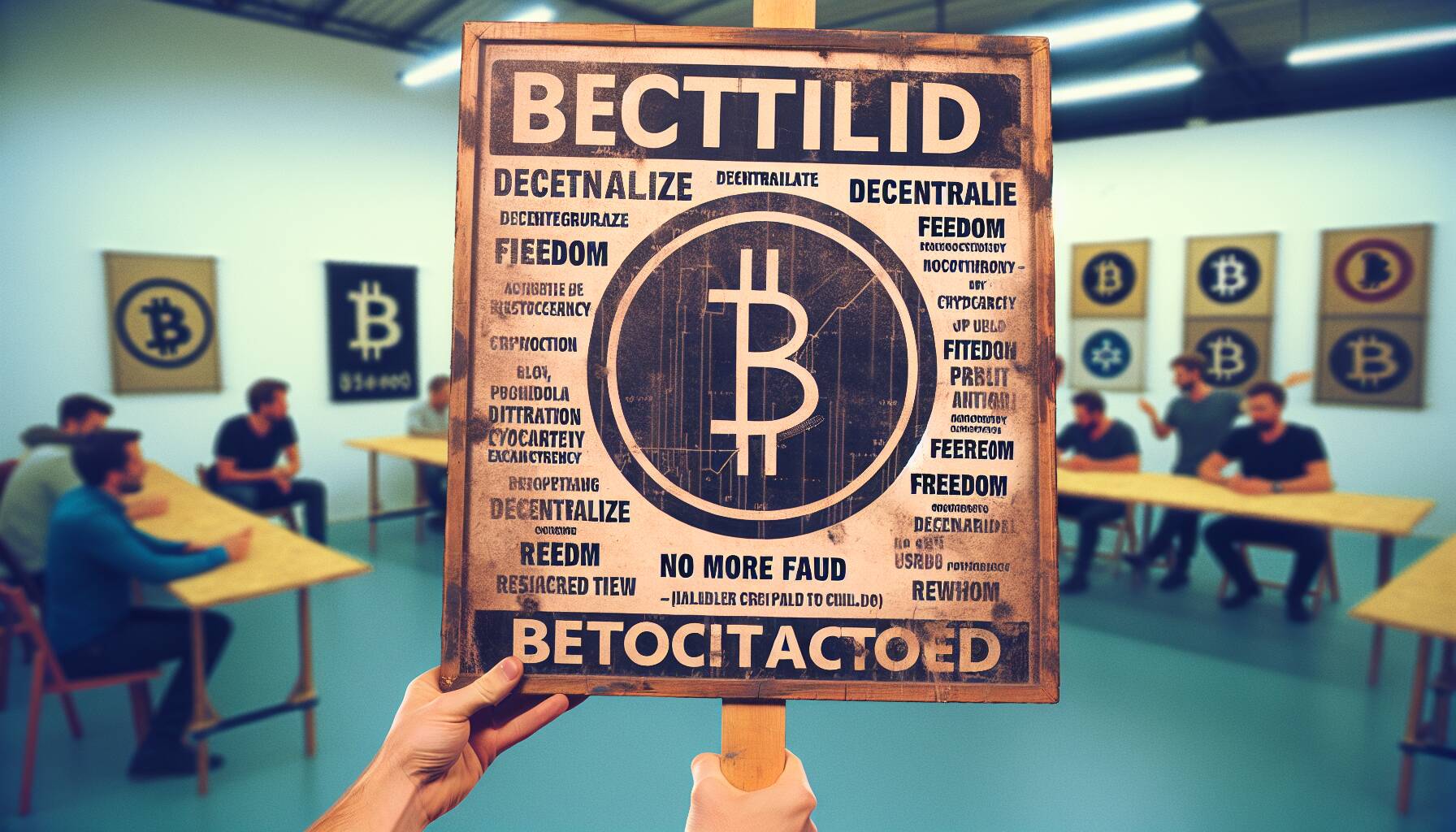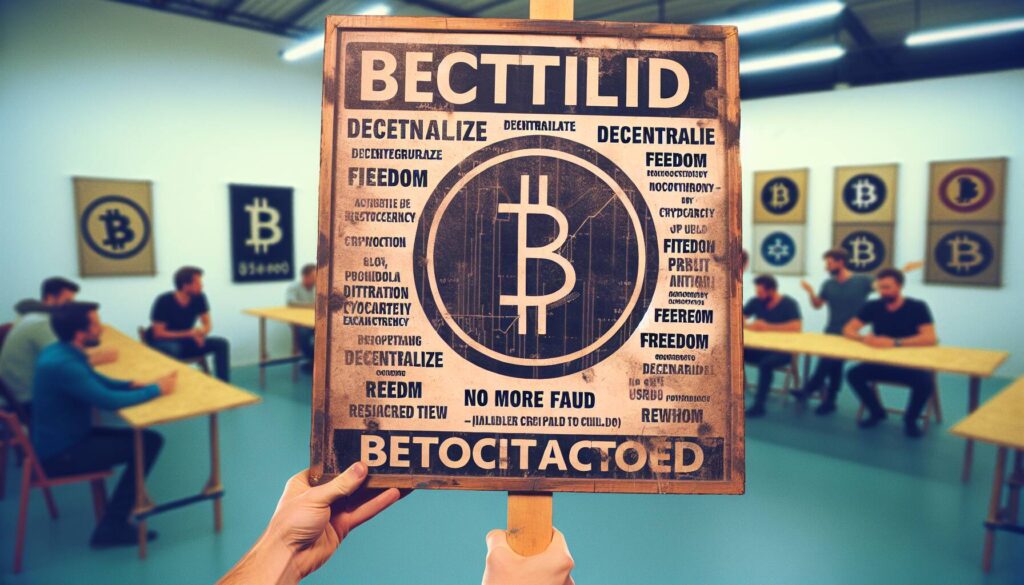In a fascinating twist of history, a cardboard sign from the early days of the cryptocurrency revolution is set to go under the hammer. This sign, held by Kolin Burges during an impassioned protest outside the Mt. Gox offices in Tokyo in February 2014, represents a pivotal moment in the crypto industry’s tumultuous journey. As the largest Bitcoin exchange at the time, Mt. Gox had unexpectedly frozen withdrawals, prompting Burges to fly from London to demand answers from CEO Mark Karpeles. Now, nearly a decade later, that very sign is being auctioned on Scare.City, with a staggering reserve price of 4.5 BTC, roughly equating to 3,000.
“At the time, it didn’t even cross my mind it could become valuable,” Burges shared in a recent interview. “It’s remarkable how things have evolved.”
Burges’s spontaneous actions sparked international media coverage, drawing attention from major financial outlets like the Wall Street Journal. His early days in Tokyo were marked by a mix of urgency and disbelief. As he stood outside the Mt. Gox office, he felt an overwhelming need to confront Karpeles, who dismissed his concerns as mere technical glitches. This surreal encounter, set against a backdrop of uncertainty, encapsulates the chaos that would soon engulf the cryptocurrency market.
The saga took a dark turn as Burges and other users faced increasing frustration, with Mt. Gox’s attempts to manage the fallout becoming increasingly desperate. Their desperate measures included inviting protesters inside to avoid media scrutiny, a move that only highlighted the seriousness of their predicament. The tension escalated, with Burges recounting a moment when Mt. Gox representatives even tried to bribe him to stop protesting, fearing that continued public outcry would jeopardize everyone’s Bitcoin. A declined payment attempt with a Mt. Gox credit card left him with a chilling impression that the company was on the brink of collapse.
“That conversation made it clear they knew more than they admitted, and the situation was far worse than publicly acknowledged,” Burges recalled.
The Mt. Gox exchange ultimately filed for bankruptcy just days after Burges’s protest. Years later, Karpeles was acquitted of embezzlement while facing a suspended sentence for data manipulation. Today, he is attempting to rebuild his reputation in the crypto space with the launch of a new exchange called EllipX and a crypto ratings company named Ungox. Reflecting on the past, Karpeles mentioned that better tools and oversight might have prevented the catastrophic events of 2014.

The Rise and Fall of Mt. Gox and Its Legacy
This article explores the events surrounding the Mt. Gox crypto exchange scandal and its lasting impact on the cryptocurrency industry and individual investors.
- Historical Context
- Mt. Gox was the world’s largest bitcoin exchange, which famously froze withdrawals in February 2014.
- This incident marked the first major financial scandal in the cryptocurrency space.
- Protest and Public Response
- Kolin Burges demonstrated outside Mt. Gox’s Tokyo office, seeking answers from CEO Mark Karpeles.
- The protest gained international media attention, highlighting investor concerns and mistrust.
- Personal Impact and Reflections
- Burges initially viewed his protest sign of little importance; it is now auctioned for 4.5 BTC (3,000).
- This reflects how unforeseen events can change the value and significance of personal actions and artifacts.
- Insider Insights
- Burges revealed that Mt. Gox representatives privately pressured him to stop protesting, indicating knowledge of their precarious situation.
- This sheds light on the lack of transparency and communication from the exchange during a crisis.
- Legal Aftermath
- Karpeles was found innocent of embezzlement but received a suspended sentence for data manipulation.
- The company’s downfall emphasizes the need for regulation and accountability in the cryptocurrency sector.
- Legacy and Innovations
- Karpeles has since established a new exchange (EllipX) and a crypto ratings company (Ungox), adapting to lessons learned from Mt. Gox.
- Emphasizes the evolution of the cryptocurrency industry and the importance of improved security and practices.
“If I had modern blockchain analytical tools in 2014, Mt. Gox wouldn’t have happened.” – Mark Karpeles
This quote reflects a critical turning point in how the industry views accountability and technology, impacting future investors and companies in the crypto realm.
The Iconic Sign from Mt. Gox: A Symbol of Crypto’s Turbulent History
The story of Kolin Burges and his memorable protest outside Mt. Gox’s Tokyo office not only marks a pivotal moment in cryptocurrency history but also highlights the intertwining narratives of innovation and caution in this digital era. Burges’ auction of his cardboard sign at a starting price of 4.5 BTC (3,000) brings forth a unique juxtaposition against more conventional collector items in the cryptocurrency space, such as limited edition NFTs or original artworks. While the auction is poised to attract enthusiasts who value historical memorabilia, it also raises questions about the perceived value of physical tokens in a predominantly digital marketplace.
Competitive Advantages: This auction presents a novel opportunity for collectors and crypto enthusiasts by providing a piece of history tied directly to a major event that shaped the cryptocurrency landscape. Unlike NFTs, which often face issues regarding environmental impact and market saturation, tangible artifacts like Burges’ sign can evoke a sense of nostalgia and authenticity. Additionally, the emerging trend of collecting crypto-related memorabilia reflects a growing recognition of the importance of historical context in valuation. By placing the sign on the auction block, Burges not only gains financial incentive but also contributes to the ongoing dialogue surrounding the evolution of crypto, making the event more significant to both fans and historians alike.
Disadvantages: However, the auction could also invite scrutiny, especially from those skeptical about the authenticity and worth of such memorabilia in an asset class that is already volatile. The nature of auctions inherently comes with risks; the reserve price is quite high, possibly alienating potential bidders who might feel that the piece does not hold the same intrinsic value as a cryptocurrency or other digital assets. Furthermore, potential investors might be wary of associating with a figure connected to the fallout from Mt. Gox, especially considering the complex legacy left behind by the incident. The auction could attract attention from both supporters and critics, which may lead to contentious discussions about ethics in digital finance.
This auction could be particularly beneficial for crypto historians, collectors, and enthusiasts who thrive on the narratives that shape the industry. For them, owning a piece of history is a way of engaging with the past, learning from it, and appreciating the strides made in technology and trust in the cryptocurrency space. Conversely, it may create challenges for those within the crypto community looking for stability and reassurance after the Mt. Gox incident. As discussions about regulation and market integrity continue, reminders of past failures like that of Mt. Gox may evoke skepticism and concern about the future of cryptocurrency exchanges and their governance.

















